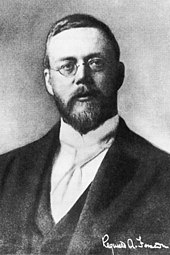Reginald Fessenden
Reginald Aubrey Fessenden (born October 6, 1866 in East Bolton , Québec , † July 22, 1932 in Hamilton Parish , Bermuda ) was a Canadian inventor and radio pioneer.
With around 500 patents with the US Patent Office , he is one of the people with the most patents. Fessenden succeeded in the first decade of the 20th century with a machine transmitter , just like Valdemar Poulsen with his arc transmitter , the world's first wireless transmission of sound, which was a pioneering achievement for both radio technology and the development of radio .
Life
Trained as an electrician, Fessenden carried out his research activities in the United States of America, where he worked as a chemist with Thomas Alva Edison on the development of insulating materials for electrical cables. In 1892 he worked with George Westinghouse on the lighting for the World Columbian Exposition in Chicago . Fessenden became professor of electrical engineering at Purdue University and a year later dean of the electrical engineering faculty at Western University of Pennsylvania .
On December 23, 1900, he conducted a first experiment in wireless voice transmission over a distance of 1.5 km. There is no evidence of the speech intelligibility of this experiment. Finally, in 1902, with the support of two Pittsburgh entrepreneurs, Fessenden founded the National Electric Signaling Company (NESCO) with the aim of setting up radio links for Morse code between Brant Rock ( Massachusetts ) and various points in the USA for the US Weather Bureau.
In 1903 Fessenden's first machine transmitter, a so-called alternator for a longitudinal wave transmitter , was built by Charles P. Steinmetz at General Electric (GE). In 1904 he commissioned GE to build an alternator that would be a thousand times more powerful.
Two years later, in 1906, Ernst Alexanderson presented the completed Alexanderson alternator , a long-wave transmitter that was installed in Fessenden's radio station in Brant Rock. There, on Christmas Eve of the same year, RA Fessenden carried out the world's first wireless music and voice transmission of mixed content, in which he read from the Bible and himself played Silent Night, Holy Night on the violin and sang. The broadcast was even received on ships in the Caribbean Sea .
In his study The Deluged Civilization of the Caucasus Isthmus 1923 he presented a reinterpretation of the mythology and geography of the early Greeks and Semites and a new model for explaining the legend of the Flood , with which he also put a reinterpretation of the events and locations described in Plato's Atlantis account up for discussion . In professional circles, however, his research results hardly met with interest and were soon forgotten again. These focused on the idea of Atlantis as a Platonic myth .
Web links
- Ross McCreath: The Start of Radio Broadcasting . Canadian Communications Foundation; January 2003. Retrieved July 2, 2021, language English.
- John S. Belrose: Fessenden and Marconi: Their Differing Technologies and Transatlantic Experiments During the First Decade of this Century . International Conference on 100 Years of Radio (September 5-7, 1995)
- Kenneth E. Behring Center: George H. Clark Radioana Collection, ca.1880–1950 . National Museum of American History, Smithsonian Institution, 2014
- Klaus Amann: A pioneering act on Christmas Eve - the first radio broadcast was received by sailors . Deutschlandfunk, broadcast “ Markt und Medien ” on December 23, 2006
- Ingo Kottkamp: 100 years of radio . Deutschlandfunk, broadcast “Calendar Sheet” on December 24, 2006
- Ralf Wendt: This is how Fessenden's first radio broadcast could have sounded . Production by Radio Corax for “100 Years of Radio” on December 22, 2006
- Background information on the Fessenden radio quiz on the program “Return of the Radio Legends” on January 28, 2013 on Radioeins
Individual evidence
- ^ [1] Radio Canada online, "Radio's true inventor". Author: Marc Montgomery. Issued December 12, 2018. Retrieved January 5, 2019, language English.
- ↑ [2] Canadian Communications Foundation website, "The Start of Radio Broadcasting". Retrieved July 2, 2021, language English.
- ^ Reginald Aubrey Fessenden: The Deluged Civilization of the Caucasus Isthmus , TJ Russel Print, 1923. Entry on Google Books . Retrieved February 4, 2016
| personal data | |
|---|---|
| SURNAME | Fessenden, Reginald |
| ALTERNATIVE NAMES | Fessenden, Reginald Aubrey (full name) |
| BRIEF DESCRIPTION | Canadian inventor and broadcasting pioneer |
| BIRTH DATE | October 6, 1866 |
| PLACE OF BIRTH | East Bolton , Quebec |
| DATE OF DEATH | July 22, 1932 |
| PLACE OF DEATH | Bermuda |
